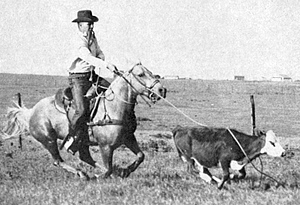 What do early-day Quarter running champion Palleo Pete and 1970s cutting champion Mr Holey Sox have in common?
What do early-day Quarter running champion Palleo Pete and 1970s cutting champion Mr Holey Sox have in common?
A little yellow roping mare named Osage Star Lady.
Foaled in 1943 on a ranch near Pawhuska, OK, Osage Star Lady was purchased for $300 as a yearling by Fred Swalley, who trained her for roping and rodeoed and match raced with her for several years near his home in Ponca City, OK. The palomino mare stood just 14 hands, but had inherited a lot of grit from her sire, Osage Star, by Oklahoma Star, as well as running blood from Osage Star’s dam, who was by Quarter Deck by Man O’War.
By the late forties, lucrative Quarter racing futurities held in northeastern Oklahoma drew Swalley’s attention and, in 1950, he bred Osage Star Lady to popular race sire Leo. The resulting foal, Leo Star Lady, won 10 out of 12 races, including two Oklahoma futurities.
In 1952, Osage Star Lady produced another Leo foal, a palomino colt, which Swalley named Palleo Pete as a nod to his sire, as well as to his yellow coat color. As a late yearling, Palleo claimed victory in numerous “unofficial” races in Oklahoma. At two, he won 13 out of 15 starts, set two track records at two distances, and was named 1954 AQHA champion 2-year-old colt.
Palleo Pete died at 12, but not before he had sired a number of stakes winners, including AQHA champion 2-year-old filly Golden Note and Miss Ginger Gay, the maternal grandam of 1974 AQHA world champion Tiny’s Gay, who would become an all-time leading sire.
Osage Star Lady dropped another colt by Leo in 1955, a chestnut named Holey Sox because of the golden spots on his white stockings. Holey Socks raced at two to earn an ROM for his owner Woody Searle, after which time he was match raced and used as a roping and barrel racing mount.
In the early sixties, Searle put Holey Sox in the hands of cutting horse trainer Jim Lee, who showed the stallion to rank sixth in the 1963 NCHA world championship standings. While on the show circuit, Holey Sox attracted the attention of some mare owners, including J.T. Fisher, who bred his Harmon Baker daughter Harmon’s Girl to the horse and got Mr Holey Sox.
Although fractious and broncy as a colt, when he finally put his mind to cattle, Mr Holey Sox had the steel to handle cattle that in those days were often recycled from go-rounds and reused for the finals.
Fisher remembered one event in Amarillo where he, Matlock Rose, Shorty Freeman and Jim Lee were among the finals qualifiers and he was the first to work. His first cow made a few promising moves, then ran toward the turnback riders, who headed her back up the fence.
“She was running wide open and Mr Holey Sox put his head down and let her run into his jaw,” Fisher told me. “It popped like a shotgun and knocked her back on her honkers. And he sat down in front of her as if to say, ‘Why don’t you do something?'”
At another event, where the cutting pen was adjacent to the bull riding arena, a Brahma bull escaped into the cutting arena while Fisher was showing Mr Holey Sox.
“The bull never did bother me and we just kept working,” Fisher noted. “But finally I noticed there weren’t any judges (judges at that time were mounted on horseback) and when I finally quit, Mr Holey Sox had worked three or four minutes. They let me rework, but I had to let my horse blow a little bit. And I went back in and won the show. In the win picture, Mr Holey Sox was wringing wet and standing with a hind foot resting like he was give out.
“He had more heart.”
Mr Holey Sox was NCHA world champion stallion for four consecutive years, from 1970 through 1973. He was NCHA reserve world champion in 1970 and 1971, and won the NCHA World Finals in 1971.
In 1973, Fisher placed fifth in the NCHA Futurity riding Plenty Holey, one of only nine performers ever sired by Mr Holey Sox.
